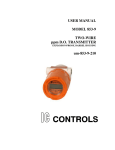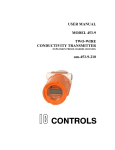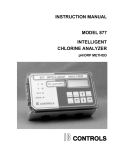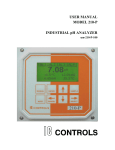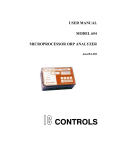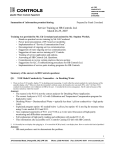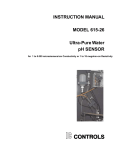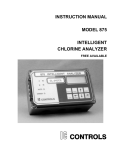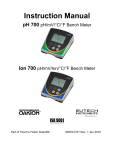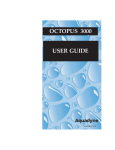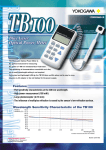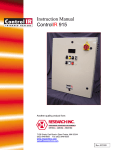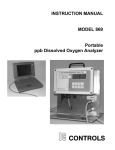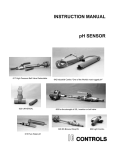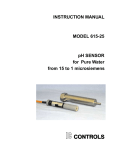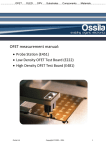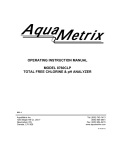Download USER MANUAL MODEL 653-9 TWO-WIRE pH/ORP
Transcript
USER MANUAL MODEL 653-9 TWO-WIRE pH/ORP TRANSMITTER EXPLOSION PROOF, BARREL HOUSING um-653-9-212 CONTENTS IC Controls CONTENTS CONTENTS..........................................................2 653-9 MENU.........................................................3 INTRODUCTION.................................................4 General.............................................................4 Features............................................................4 INSTALLATION..................................................5 Transmitter Mounting......................................5 Field Mounting Orientation.............................5 Transmitter Wiring..........................................6 Hazardous Location Information.....................7 Sensor Mounting..............................................8 Sensor Wiring..................................................8 Instrument Shop Test Startup..........................9 STARTUP...........................................................10 Transmitter Startup Tests...............................10 Selecting the pH or the ORP option..............10 Calibration Settings........................................11 Serial Number Display...................................11 EASY MENU......................................................12 Remembers Where You Were.......................12 Home Base ― Press SAMPLE......................12 Arrow Keys....................................................13 DIAG and ERROR Keys...............................13 Enter Key.......................................................13 EDIT MODE.......................................................14 Editing by Selecting a Setting........................14 Editing a Numeric Value...............................14 Key Functions in Edit Mode..........................15 510 REMOTE KEYPAD....................................16 Remote Keypad Operation.............................16 ID Key............................................................16 NUM Key.......................................................17 SECURITY.........................................................18 Enabling Password Security..........................18 Disabling Password Security.........................19 Entering a Password.......................................19 pH CALIBRATION............................................21 Standardizing — Single-Buffer Calibration. .22 Calibrating – Two-Buffer Calibration...........23 Grab Sample Standardization........................25 Selecting a Buffer..........................................26 Electrode Maintenance..................................27 Replacing Electrodes.....................................27 Output Hold in Calibration Mode..................27 Manual Calibration of Offset and Slope........28 Temperature Compensation for pH...............28 Manual Temperature Compensation..............28 ORP CALIBRATION.........................................29 Selecting a Standard for Calibration..............29 ORP Standardization......................................29 Electrode Life.................................................30 ORP - Manual Calibration.............................30 4 mA to 20 mA OUTPUT SIGNAL...................31 Simulated 4 mA to 20 mA Output.................31 Output Damping.............................................32 CAUTION AND ERROR MESSAGES.............33 Error and Caution Messages for pH..............33 Error and Caution Messages for ORP............35 Error Messages for Temperature...................35 CONFIGURATION OF PROGRAM.................36 TROUBLESHOOTING......................................38 Transmitter Troubleshooting.........................39 pH Electrode Troubleshooting.......................40 ORP Electrode Troubleshooting....................41 ELECTRONIC HARDWARE ALIGNMENT...42 DISPLAY PROMPTS.........................................43 GLOSSARY........................................................44 Appendix A — Default Settings.........................45 Appendix B — Parts List....................................46 Appendix C — 653-9 pH/ORP Specifications.. .47 DRAWINGS.......................................................48 Display Component Location: D5000223.....48 Micro Board Wiring & Component Location: D5000224.......................................................49 Main Board Component Location: D5000229. . 50 Feed-through Component Location: D5000225 ........................................................................51 Wiring - Analyzer: D5000238.......................52 Wiring using 600-13 Interface: D5000239....53 Wiring using 600-16 Interface: D5140317....54 PCB Assembly: D4000075............................55 2 inch Pipe Mounting: D4000076..................56 Mounting Options: D4000074.......................57 INDUSTRIAL PRODUCTS WARRANTY.......58 INDEX................................................................59 © Copyright 2015 IC Controls Ltd. All rights reserved. Page 2 www.iccontrols.com um-653-9-212 IC Controls 653-9 MENU 653-9 MENU pH/ORP CHANGES Areas shaded in dark orange indicate program settings which can be changed by the user. Menu areas shaded in light blue indicate view-only. NOTE: [or.dA] shown in main menu when ORP option selected. Illustration 1: Menu layout um-653-9-212 www.iccontrols.com Page 3 INTRODUCTION IC Controls INTRODUCTION The model 653-9 as shipped from the factory is calibrated and should not require recalibration other than a minor software zero and span adjustment to match your receiver or recorder. As received, the transmitter's span has been calibrated to 0 pH to 14 pH or - 2000 mV to 2000 mV, depending on the input selected. These ranges will cover most common processes. General The 653-9 is one of a series of explosion-proof, barrel housing type, two-wire transmitters. It is considered to be a two-wire device because both the power and signal use the same two wires. In the case of pH or ORP, a pH or ORP signal corresponding to the actual pH or ORP is converted to a 4 mA to 20 mA signal which is carried along the same two wires as the 24 VDC power used to power the device. Features 1) Instrument housing which is: —Class 1, Groups B, C & D; Class 2, Groups E, F & G rated. —NEMA 4, Water- and dust-tight rated. —NEMA 7, Hazardous; for indoor use Class 1, Groups A, B, C & D as defined by NEC. —FM Approved. —CSA Certified. —Cenelec Certified, EExd IIC, IP66. 2) Ability to mount at any 90 degree angle from normal. 3) Operation via infra-red remote control. 4) Automatic temperature compensation. 5) Standard ¾ inch NPT feed-through conduit provides ample space for BNC and TC wires to pass. 6) Steering diode protects 4 mA to 20 mA power from damaging electronics. Note: Refer to Appendix C for complete transmitter specifications. Page 4 www.iccontrols.com um-653-9-212 IC Controls INSTALLATION INSTALLATION Transmitter Mounting The sensor is typically supplied with a 1.5 m (5 foot) lead as standard. The transmitter should be kept within this distance. The transmitter should be positioned to allow the sensor, while connected, to be removed and the electrode tip placed in a beaker on the floor for cleaning or calibration. Assume the safest place for the beaker is on the floor the service person stands on. The electrical connector is on the left side, and the electrode connectors are on the right side. Horizontal separation between rows of transmitters should allow for electrode leads which need periodic replacement, and the electrical connector. IC Controls recommends 10 cm (4 inch) minimum separation between rows/columns. As standard, the 653-9 comes with a 2 inch pipe mounting kit; refer to drawing D4000076 for enclosure mounting dimensions. Field Mounting Orientation The 653-9 can be mounted in any 90 degree increment from standard. Refer to drawing D4000074. Use the procedure below to select the desired mounting orientation. 1. Calibrate the transmitter to the desired range in the instrument shop. 2. Take the transmitter to field location to check orientation. 3. If the transmitter is in the correct orientation go to step 10. 4. If the transmitter is not in the standard orientation, return to instrument shop. 5. Loosen front cover tamper set screws and remove front cover. 6. Undo the four Phillips screws and remove front panel to display PCB board. Refer to drawing D4000075. 7. Undo the four ¼ inch diameter ⅝ inch long hex standoffs and remove main PCB. 8. Orient main PCB in desired direction keeping in mind four-position header is the top. 9. Refasten standoffs following steps 6 and 7 in reverse order. 10.Mount transmitter with the hardware provided; pipe mount only. um-653-9-212 www.iccontrols.com Page 5 INSTALLATION IC Controls Transmitter Wiring The transmitter requires 24 VDC power via the 4 mA to 20 mA output, TB200 terminals 1 and 2. For stable operation, the microprocessor needs a good ground. A good ground connection can typically be made using a shielded 4 mA to 20 mA wire connected to ground in the transmitter and to a local earth rod, or earth at the 24 VDC power supply. The transmitter requires 24 VDC to operate properly. The “on board” regulation allows the supply to vary to any level between 16 VDC to 40 VDC without affecting the transmitted signal. To hook up power to the transmitter, perform the following wiring procedure. 1. Ensure 24 VDC power is not hooked up at control room or DCS end. 2. Unscrew tamper resistant set screw and remove rear cover. 3. Using 18AWG to 22 AWG wire, hook up 4 mA to 20 mA power connections to TB200, + 24 VDC and RETURN terminals as shown in illustration 2. Illustration 2: Power Wiring Illustration 3: Maximum loop resistance Page 6 www.iccontrols.com um-653-9-212 IC Controls INSTALLATION Hazardous Location Information Installation should be performed in compliance with all applicable local electrical safety codes. The 653-9 uses 24 VDC supply, generally considered low hazard in general purpose applications. However, IC Controls recommends that the following safety practices be followed. • Flex conduit should be installed within 18 inches of the enclosure. • Ensure all covers are on and firmly in place before power is applied. • Set tamper resistant set screws. • Disconnect power before opening covers. NOTE: pH/ORP sensors and RTD temperature compensators are passive and meet the intrinsic safe definition of a simple device. A simple device is either a passive device such as an RTD or a component with such a small signal that a spark is not possible. Simple devices do not require certification as they are safe by nature. NOTICE OF COMPLIANCE US This meter may generate radio frequency energy and if not installed and used properly, that is, in strict accordance with the manufacturer’s instructions, may cause interference to radio and television reception. It has been type-tested and found to comply with the limits for a Class A computing device in accordance with specifications in Part 15 of FCC Rules, which are designed to provide reasonable protection against such interference in an industrial installation. However, there is no guarantee that interference will not occur in a particular installation. If the meter does cause interference to radio or television reception, which can be determined by turning the unit off and on, the user is encouraged to try to correct the interference by one or more of the following measures: * Reorient the receiving antenna * Relocate the meter with respect to the receiver * Move the meter away from the receiver * Plug the meter into a different outlet so that the meter and receiver are on different branch circuits If necessary, the user should consult the dealer or an experienced radio/television technician for additional suggestions. The user may find the following booklet prepared by the Federal Communications Commission helpful: How to Identify and Resolve Radio-TV Interference Problems. This booklet is available from the U.S. Government Printing Office, Washington, D.C., 20402. Stock No. 004-000-00345-4. CANADA This digital apparatus does not exceed the Class A limits for radio noise emissions from digital apparatus set out in the Radio Interference Regulations of the Canadian Department of Communications. Le present appareil numérique n’ émet pas de bruits radioélectriques depassant les limites applicables aux appareils numériques (de la class A) prescrites dans le Règlement sur le brouillage radioélectrique édicté par le ministère des Communications du Canada. um-653-9-212 www.iccontrols.com Page 7 INSTALLATION IC Controls Sensor Mounting Flow sensors should be mounted tip down at an angle anywhere from 15 degrees above horizontal to vertical; 15 degrees above horizontal is best because air bubbles will rise to the top and grit will sink both bypassing the sensor. Submersion sensors should not be mounted where a lot of air bubbles rise in the tank; they will cause spikes in the pH/ORP readout. If a bubble is allowed to lodge in the electrode tip, electrical continuity between the sensitive glass and the silver/silver chloride element may be disrupted. Sensor Wiring Ensure 24 VDC power is disconnected at supply end. If using direct connection, the preamp is connected to TB100 which is a six-place terminal block. The color code for wiring is shown in illustration 4. The sensor is connected via the A2500054 preamp BNC fitting, wire colors in the illustration refer to the sensor lead and wires from the A2500054 preamp. Drawing D5000238 has detailed wire colors to TB100. Illustration 4: Standard direct sensor wiring If using a standard remote 600-13 pH interface, please refer to drawing D5000239 for wiring. If using a differential remote 600-16 pH interface, please refer to drawing D5140317 for wiring. Page 8 www.iccontrols.com um-653-9-212 IC Controls INSTALLATION Instrument Shop Test Startup 1. Apply 24 VDC power to the transmitter. 2. Hook up the sensor via TB100 and remove orange protective cap from sensor. 3. Select either pH or ORP depending on your sensor and application. 4. Place the pH sensor in 7.0 pH buffer or the ORP sensor in 66 mV standard. 5. The 653-9 pH/ORP transmitter should come up reading close to 7 pH or 66 mV. 6. Perform a standardize calibration for a reading of pH 7.00 ± 0.02 pH units or 66 mV ± 2.0 mV. Allow 30 minutes warm-up time for the electronics to stabilize. 7. To check for general performance, place the pH electrode in pH 4 or pH 10 buffer. The display should read approximately pH 4 or pH 10. For ORP, place the ORP electrode in 263 mV standard; the display should read approximately 263 mV. 8. Run the second buffer, SLOP (span) calibration to trim the reading to 4 pH or 10 pH (or 263 mV) if needed. 9. Before putting the transmitter into operation, verify the settings to ensure that they agree with the intended setup. For the 4 mA to 20 mA output, set high limit and low limit. 10.Set preference for temperature, °C or °F, in [CONF] [unit]. 11.Set desired input signal damping if known; default is 1 second. 12.The transmitter is now ready for field installation. um-653-9-212 www.iccontrols.com Page 9 STARTUP IC Controls STARTUP If the transmitter is new and has not been installed, then follow the procedures described in Installation, Electronic Hardware Alignment and Configuration of Program before mounting. Mounting and wiring procedures for new installations vary with equipment options — refer to drawing section for instructions. If the transmitter has been previously installed, all that is required is to attach the electrode to the transmitter and then turn on the power. The transmitter will go through it's automatic startup procedure any time power to the transmitter is lost for more than a few seconds. The startup procedure will initialize the transmitter program, perform error checks, scroll the unique 10 digit serial number of the unit and then proceed to display the pH/ORP reading and function normally. All program settings, calibration settings, and default values will have been retained by the transmitter as the memory has battery backup. Transmitter Startup Tests The startup procedure will begin by scrolling a flashing [IC CONTROLS] across the display while performing memory tests. The transmitter will proceed to display, in sequence, the transmitter model number, in this case [653-9], any software option numbers, and the program version number, e.g.[2.00]. The program then proceeds to perform display tests; each of the implemented display segments will light up in turn. If the transmitter passes all the startup tests then the hardware is functioning properly and the transmitter will proceed to display pH/ORP, or error messages, if detected. If the transmitter displays +Err or -Err, this indicates that the input is off-scale. An off-scale error can indicate that the electrode is not in solution, is off-scale, or is not connected properly. If the display periodically flashes [Err], go to the error display section; press ERROR key or select [Err] from the main menu to view the error codes detected by the transmitter. Selecting the pH or the ORP option The 653-9 is designed as a single input pH or ORP transmitter. It can be field configured to change from the pH option to the ORP option by a simple menu selection. When pH is selected the ORP menu will disappear. Also when ORP is selected the pH menu will disappear. To select input option, select [CONF] from main menu, press 6 (right arrow) to view next menu. Use keys 2 or 5 (up and down arrow) to display [OPtn]. Press 6 (right arrow) and pH or ORP will be displayed. If the incorrect input is displayed, press ENTER to cause display to flash. Use keys 2 or 5 (up and down arrow) to change display and press ENTER to stop flashing display and accept the changed setting. The input has now been changed. Page 10 www.iccontrols.com um-653-9-212 IC Controls STARTUP Calibration Settings If the transmitter was calibrated previously, then the transmitter will use the calibration settings from the last successful calibration, otherwise default settings are used. Error and caution messages generated during the last calibration will remain in effect. For the pH transmitter, IC Controls recommends a full two-buffer chemical calibration after initial startup. Refer to pH Calibration section for calibration procedure. Transmitter settings and parameters can be viewed and/or changed at any time. Refer to the menu on page 3; the areas shaded in dark orange indicate program settings. Serial Number Display The transmitter's unique serial number can be viewed at any time. Press the DIAG key or the SAMPLE key 4 times to call up the startup display routine above. This does not change any customer settings. The serial number is the 10 digit number that scrolls across the screen. um-653-9-212 www.iccontrols.com Page 11 EASY MENU IC Controls EASY MENU The layout of the program is shown in the menus found on page 3. The menu can be used as a quick reference guide to all the transmitter functions. Remembers Where You Were The transmitter remembers where home base is, which areas of the menu were used last, and it will loop around the columns in the menu. The menu can be explored using the arrow keys to find any parameter. Pressing the SAMPLE key will return display to home base. Pressing the → key will return the user to exactly the area of the menu most recently accessed. Home Base ― Press SAMPLE The SAMPLE key's function is to give the user a known starting point displaying the home sample or home input. The SAMPLE key is usable from anywhere in the menu. The program will safely abort whatever it was doing at the time and return to displaying the pH/ORP reading. The pH/ORP display is the home base display for the transmitter. The transmitter's two inputs, pH/ORP and temperature, are arranged underneath each other at the left-hand side of the menu. Use the ↑ or ↓ key to display each of the readings in turn. Illustration 6: pH Home base Illustration 7: ORP Home base Features 1. The transmitter has a built-in timer which returns the program to displaying the home base if no key has been pressed for 15 minutes. This time-out has the same effect as pressing the SAMPLE key. 2. When in doubt as to what the transmitter is displaying, pressing the SAMPLE key will ensure it is displaying pH/ORP. Pressing the ← key will show the sample parameter being displayed. Pressing the → key will return to displaying the sample reading. 3. If security has been enabled, the timeout will change the access level back to 0 or 1 automatically, which gives the user read-only access. The user will have to enter an appropriate password to go to a higher access level. Page 12 www.iccontrols.com um-653-9-212 IC Controls EASY MENU Arrow Keys The arrow keys on the keypad are used to move around in the menu. The same keys can have other functions as well, refer to Edit Mode. Example: Press SAMPLE to get to home base. Press the → key. One of the prompts in the main menu column will be displayed - refer to illustrations 8 and 9. Use the ↑ key to display the prompt above; at the top, the program will loop around. Press the ↑ key until [CONF] is displayed. Press the SAMPLE key to return to the pH or ORP display. Press the → key again and [CONF] will be displayed again. Illustration 8: ORP main menu Illustration 9: pH main menu DIAG and ERROR Keys The DIAG and ERROR keys are used to access the diagnostic and error or alarm conditions in the transmitter. Refer to the Caution and Error Messages section for a description of these key functions. Enter Key The ENTER key is used to access the ability to change values or edit settings. um-653-9-212 www.iccontrols.com Page 13 EDIT MODE IC Controls EDIT MODE Edit mode is used to change a numeric value or to select between different options. The values and settings which can be edited are identified by the darker shading in the menus. Any frame which has a white background cannot be modified by going into edit mode but can be viewed. Editing by Selecting a Setting Examples of selecting a value are on/off settings and switching between different units (eg. metric or imperial). Editing a value is like picking an option from a list; only one item on the list can be viewed at a time. Example: Turning output off. From the menu, select [out] [ON.OF]. The transmitter will now display either [ON] or [OFF], which are the two choices. To change the setting, press ENTER to go into edit mode. The display will start blinking. Use the ↑ or ↓ keys to switch between the possible options, which in this case are [ON] and [OFF]. When [ON] is displayed, press ENTER again to accept the new setting and leave edit mode. Editing a Numeric Value Numeric values such as input damping are adjusted by going into edit mode and then adjusting each digit until the new value is displayed. Use the ← and → keys to move between digits and use the ↑ and ↓ keys to adjust each digit. When ENTER is pressed to go into edit mode, two things will happen. First, the last digit will start blinking to show that this digit can be changed. Second, any blank spaces will change to zeros and a plus or minus sign will appear. Now each digit can be accessed. Change between positive and negative numbers by switching between plus and minus sign using the ↑ or ↓ key when the plus/minus segment is blinking. Press ENTER again to leave edit mode. Before the new value is changed, the transmitter will check the new value to make sure that it is within range. If the new value is lower than the lowest value allowed for that frame then the transmitter will use the lowest allowable value instead of the new value entered. Likewise, if the new value entered is higher than allowable then the highest allowable value is used instead. The transmitter will display whatever value it has stored in memory. Example: Change the low from 0 pH to 2 pH. From the menu, select [out] [LO]. The current set-point (e.g. [0.00]) will be displayed. Press ENTER to select edit mode. The display will change to [+ 00.00] and the last digit will start blinking. Press ← twice to move left two digits. The third digit from the end will now be blinking. Press the ↑ key to change the ‘0’ to ‘2’. Press ENTER again and the display will change from [+00.00] to [+02.00] indicating that the new value has been stored in memory. The 4 mA to 20 mA low set-point has now been changed from 0.00 pH to 2.00 pH. Press the ← key to display [LO], [out] etc. Page 14 www.iccontrols.com um-653-9-212 IC Controls EDIT MODE Key Functions in Edit Mode Enters edit mode. The entire display or a single digit will blink to indicate that the Transmitter is in edit mode. Press the ENTER key again to leave edit mode and accept the new value. Adjusts blinking digit upward or selects the previous item from the list. If a ‘9’ is displayed then the digit will loop around to show ‘0’. Adjusts blinking digit downward or selects the next item from the list. If a ‘0’ is displayed then the digit will loop around to show ‘9’. Numeric values only: move right one digit. If blinking is already at last digit, display will loop to the +/- sign on the left. Numeric values: move left one digit. If blinking is at the +/- sign then blinking goes to the last character. Settings: restore the initial value if it was changed. Otherwise leave edit mode without doing anything. Illustration 10: Infra-red remote keys used in edit mode um-653-9-212 www.iccontrols.com Page 15 510 REMOTE KEYPAD IC Controls 510 REMOTE KEYPAD The 510 remote keypad is required to operate the explosion proof versions of the 53 series. The 510 is a battery powered infra-red light based remote control similar to a TV remote. In addition, the 510 has components that make it intrinsically safe. The 510 operates through the front viewing window of the 653-9 case. It allows a fully functional modern transmitter with multiple external adjustments and access to microprocessor intelligence, without the cost and risks of multiple ports into the explosion proof enclosure. Remote Keypad Operation Illustration 11: Infra-red remote, model 510 The 510 remote operates exactly like a front panel mounted keypad, with the exception that you have to point the IR diode at the front of the transmitter. The keys are laid out in the same pattern as a standard IC Controls front panel keypad, with their functions identified in orange. By default, the transmitter recognizes all these commands, and is said to be in CMD (command) mode. The 510 remote has extra keys for AUTO, MAN (manual), DIAG (diagnostics), ERR (error), ID (identity), NUM (black numbers), CMD (orange commands). These keys allow optional functions available with particular IC Controls products. ID Key The ID key is used when an array of transmitters are grouped close together and it is possible for more than one transmitter to “see” and “respond to” the same IR remote signal. IC Controls ships the unit with ID equal to 01 by default; it can be field changed to any two digit number up to 99. Where an array is planned it is easiest to preset the ID to a unique number before installation. However, by stepping close enough that only one unit sees the signal the ID can be changed in the installation. Unit ID’s can be changed in the [CONF] menu under [ir.id]. Selecting the desired unit using ID 1. Press the 510 “ID” key once. All units that can “see” the signal will display their ID for 5 seconds. Example: the transmitter responds with [id.12]. 2. Within the 5 seconds, type the ID code of the transmitter you want using the black numbers on the 510. Example: All transmitters respond with [id.1], then [id.12] as the digits are pressed. 3. Operate the identified (active) unit as normal. All the other inactive units will ignore the 510 signals, except for the ID key. 4. To activate a different transmitter, repeat steps 1 and 2. Page 16 www.iccontrols.com um-653-9-212 IC Controls 510 REMOTE KEYPAD NUM Key The ID key is useful for entering numbers directly, rather than scrolling with the arrow keys. The unit responds to the NUM key with [—N—] and to CMD with [—C—]. Numbers update in the natural left to right sequence. Entering numbers using NUM 1. Proceed to the value to be edited, then press ENTER. 2. With the display flashing (edit mode), press NUM, then the desired value. 3. With the correct number flashing, press CMD and then ENTER; the display will stop flashing and the edited number will be installed. um-653-9-212 www.iccontrols.com Page 17 SECURITY IC Controls SECURITY The 653-9 has a built-in password protection system. This security system is disabled by default and does not need to be enabled if no password protection is necessary. If the password protection system is not enabled, then the user will have unrestricted access to all transmitter settings available through the menu as described in this manual. Having security disabled provides the same access to the program as being at access-level 2 at all times. With security enabled, anyone can view settings anywhere in the program. When proper access rights are not warranted, the program will display [PASS] for 2 seconds, indicating that a proper password must be entered before being allowed to proceed. Access-Level Description 0 View-only access to all settings 1 Access to all settings except for configuration menu. Usage: Operator access. No changes can be made to configuration and passwords cannot be changed. 2 Access to all settings. This allows the same access to program as when password security is not enabled. Usage: Installation, management. Table 1: Security access levels Enabling Password Security When security is disabled both password 1 and password 2 are set to “0000.” Security is enabled by setting password 2 to a non-zero value. Select [CONF] [PAS.2] from the menu. The transmitter will display [0000]. Use the arrow keys to change the display to the desired password for level 2. Pressing SAMPLE at any time will safely cancel password entry. Press ENTER to enter the password into memory and to enable password security. The transmitter program automatically returns to the configuration menu. With only password 2 set to a non-zero value: level 2 access is required to make changes in the configuration menu but all other settings are unprotected. Effectively, the user will always have at least level 1 access. At this point password 1 is still “000.” You may optionally enable operator access control or level 1 security by changing the level 1 password from “000" to a non-zero value. Change the password by selecting [CONF] [PAS.1] from the menu, then entering an appropriate 3-digit password. Write down the passwords set and store them in a secure place; once a password has been set, there is no way to redisplay it. Since passwords are set in the configuration menu, level 2 access is required to change either password. If the level 2 password has been forgotten, there is no simple way to regain access to the transmitter. Contact the factory if you find yourself locked out of the transmitter. Page 18 www.iccontrols.com um-653-9-212 IC Controls SECURITY Disabling Password Security Password security can be disabled by setting the level 2 password to “0000.” In order to change the password, level 2 access is required to enter the program. Select [CONF] [PAS.2] from the menu, then press ENTER when the program displays [0000]. Both passwords 1 and 2 are set to “0000" and security is now disabled. The main menu will be changed to exclude the [PASS ] frame, and the configuration menu will no longer have the [PAS.1] frame. Entering a Password With security enabled, select [PASS] from the main menu. The transmitter will display [0000]. Using the arrow keys, edit to display level 1 or level 2 password, then press ENTER. The program will display [good], followed by the access level before returning to the main menu. If an incorrect password was entered, the program displays [bAd] instead. Refer to illustration 12 to see how the program validates a password. Level 1 or level 2 access is now acquired for as long as the transmitter is being operated. The access level will automatically be restored to level 0 after no key has been pressed for 15 minutes. This 15-minute time-out will also redisplay the main sample. It is good practice to return the transmitter to level 0 access (or level 1 access if password 1 is set to “000”) once the access-level user has finished using the transmitter. This is accomplished by selecting [PASS] from the main menu, then pressing ENTER with [0000] displayed. Password Example — a Quick Tour With security disabled, select [CONF] [PAS.2] from the menu. Set the level 2 password to “0002". Select [CONF] [PAS.1] from the menu. Set the level 1 password to ”001." Security is now enabled. Select [PASS] from the main menu. Press ENTER with [0000] displayed. The transmitter will display [ACC.0] to indicate we are now at access level 0. Try changing the output low setting. Select [out] [LO] from the menu. The current value will be displayed. Press ENTER to go into edit mode. The transmitter will display [PASS] for 2 seconds because a password needs to be entered first. Level 1 security is needed to change this setting. Select [PASS] from the main menu again. Change the displayed value to [0001], which is the level 1 password and press ENTER. The transmitter will display [good], followed by [ACC.1], indicating that the password is valid and that level 1 access has been achieved. Try changing the output low setting again. This time, edit mode can be attained unhindered. Select [PASS] from the main menu again. Enter the level 2 password, which is “0002.” Change the level 2 password to “0000” in order to disable password security. Password 2 is found in the configuration menu and therefore requires level 2 access before it can be accessed. Select [CONF] [PAS.2] from the menu. Press ENTER with [0000] displayed. Both passwords are set to “0000” again and password security is disabled. um-653-9-212 www.iccontrols.com Page 19 SECURITY IC Controls Illustration 12: Password validation Page 20 www.iccontrols.com um-653-9-212 IC Controls pH CALIBRATION pH CALIBRATION The pH input is calibrated using one of several methods. A one-point standardization adjusts the electrode offset while maintaining the previous slope. The two-point calibration combines the results of the standardization with the results of the buF2 calibration and calculates the slope as well as the offset. The grab sample calibration is a convenient method to adjust the electrode offset in cases where it is not possible to physically remove the pH electrode from the process. Illustration 13: pH menu A calibration is easily accomplished by selecting an appropriate buffer, placing the electrode in the buffer solution, and letting the transmitter do the rest. The transmitter tests for electrode stability and performs many diagnostic tests during calibration. Automatic stability testing takes most of the guesswork out of deciding whether a reading is acceptable or not. The internal diagnostic tests will activate warning or error messages if faulty operation is suspected or detected. Errors detected during calibration will not cause the transmitter to lock up. Buffers automatically recognized by the 653-9 are: red 4.01 pH buffer, part number A1100051 green 7.00 pH buffer, part number A1100052 blue 10.0 pH buffer, part number A1100053 These buffers come in 500 mL bottles and are also available in six-packs. Refer to Appendix B for ordering information. um-653-9-212 www.iccontrols.com Page 21 pH CALIBRATION IC Controls Standardizing — Single-Buffer Calibration Standardizing the transmitter causes the transmitter to calculate the offset for the pH electrode, which can be viewed both before and after standardization. The electrode slope value determined during the last buF2 calibration will be maintained. Press SAMPLE to display the pH reading. Press → to reach the main menu, then use the ↑ or ↓ key to display [CAL]. Press → again, then use the ↑ or ↓ key to display [buF1]. Press → again to reach the next menu. A buffer needs to be selected with which to calibrate the transmitter. Use either automatic detection, a custom value, or one of the standard buffers (4, 7, 10). For further details, refer to Selecting a Buffer for an explanation of the buffer selection process. Place the electrode in the buffer solution, then press → again to start the calibration process. The display will show a flashing pH reading to indicate that the transmitter is reading pH in calibration mode and is waiting for the operator to press ENTER once the pH has stabilized. As soon as the electrode has stabilized and the ENTER key is pressed, the display will stop flashing, the electrode offset will be calculated, and the new offset (standardize) will be entered in memory. Confirm the single-point calibration precision by repeating the calibration. There should be close agreement between the readings and the buffer, however, small adjustments may be handled by repeat calibrations. Calibrations may be redone or started over at any time. Press ← to display the selected buffer (eg. [Auto]), then → to restart the calibration. Note: If the temperature is far from 25 °C, the transmitter will display the temperature compensated pH value of the pH buffers. Refer to Selecting a Buffer section for more information. If the transmitter detects or suspects any problems during calibration, a caution or error message will appear. Refer to the Caution and Error Messages section for a description of each message. If a potential problem has been detected, eg. a large offset, then the transmitter has successfully completed standardization. The caution message simply informs the user that poor performance is suspected and will be compensated for by the microprocessor. Illustration 14: First buffer Page 22 www.iccontrols.com um-653-9-212 IC Controls pH CALIBRATION If a more serious error message is displayed, the electrode exhibits signs of major problems (eg. the buffer selected was not the buffer used so the offset would be large), then the standardization was not successful. The transmitter has retained the values from the last successful calibration. Press any key to acknowledge the error. The transmitter will return to the buffer selection menu and display the selected buffer, eg. [Auto]. Refer to the Caution and Error Messages section and follow appropriate corrective action; retry the calibration. Press any key to resume normal operation after a caution or error message has appeared. Calibrating – Two-Buffer Calibration Fully calibrating the transmitter involves calculating both the offset and the electrode efficiency or slope to match a particular electrode pair, which can also be viewed both before and after two-buffer calibration. The electrode slope will be calculated as a percentage of Nernstian response. First calibrate the offset with [buF1] by following the procedure for Standardizing - Single-Buffer Calibration. Secondly, return to the calibration menu and display [buF2] to calibrate the pH glass efficiency or slope. Press → to reach the buffer selection menu. Use the ↑ or ↓ keys to select either automatic buffer recognition, a custom value, or one of the standard buffers (4, 7, 10). The second buffer should be at least 1 pH unit higher or lower than the buffer used for the standardize procedure. For further details, refer to Selecting a Buffer for an explanation of the buffer selection process. Press → again to start the calibration process. The calibration with the second buffer works similar to a standardization, except that additional error checking is possible and the slope efficiency will be calculated. If an error occurs at this point, the settings from the standardization ([buF1] selection) will be kept. Either retry the calibration with a second buffer ([buF2]), or resume normal operation with the settings from the standardization. Example: Assume the process normally has a pH in the caustic region, above 7 pH. Calibration will be performed using 7 pH and 9 pH buffer values (the 9 pH buffer was chosen to demonstrate the full functionality of the 653-9). Press SAMPLE to go to the pH display. Press →, then use the ↑ or ↓ keys to select [CAL]. Press → again to reach the calibration menu. Use the ↑ or ↓ keys to select [buF1], then press → again to select a buffer from the menu. Illustration 15: Second buffer um-653-9-212 www.iccontrols.com Page 23 pH CALIBRATION IC Controls First, use auto-buffer recognition ([AUTO] prompt). Put the sensor in the first buffer. Start with 7 pH buffer solution, then press → to start the calibration process. The display will flash the pH reading to indicate that the transmitter is reading pH in calibration mode and is waiting for the operator to press ENTER once the pH has stabilized. When the electrode has stabilized and the ENTER key is pressed, the display will stop flashing, the sensor offset will be calculated, and the new offset (standardize) will be entered into memory. The transmitter will adjust it's calibration settings and show 7.00 pH. To calibrate with the second buffer, press ← twice to return to the [buF1] display. Press the ↓ key to display [buF2]. Press → to select the second buffer. This time select [cuSt] (custom or non-standard buffer) from the menu. The transmitter would not recognize a 9 pH buffer in auto-buffer-recognition mode (only 4, 7, or 10). With [cuSt] displayed, press →, then use ↑ or ↓ key until you get 9.00 on the display. Then press → to start the calibration. As soon as the electrode has stabilized and the ENTER key is pressed, the display will stop flashing, the electrode slope will be calculated, and the new slope (efficiency) will be entered into memory. The transmitter will adjust its calibration settings and show 9.00 pH. Press SAMPLE to return to the main pH display. Verify that the slope has been calculated, press → twice, then use the ↑ or ↓ keys to display [SLOP] in the pH menu. Press → again to display the slope efficiency. A good electrode will have an efficiency (or slope) of between 85% and 102% of Nernstian theoretical response. Confirm the second point calibration precision by repeating the calibration. There should be close agreement between the reading and the buffer, however, small adjustments may be handled by repeat calibrations. NOTE: If the temperature is far from 25 °C, and auto was used, the transmitter will be displaying the compensated pH value of the buffer. Refer to Selecting a Buffer section for more information. Page 24 www.iccontrols.com um-653-9-212 IC Controls pH CALIBRATION Grab Sample Standardization The grab sample standardization method provides an easy way to single-point adjust the pH sensor without removing the sensor from the sample. Grab sample standardization requires the user to determine the actual pH of the sample using an alternative method. For example, if the transmitter is reading 3.55 pH and laboratory analysis determines the actual pH of the sample to be 3.42 pH, the grab sample method can be used to adjust the offset so that the previous 3.55 pH reading changes to 3.42 pH. Illustration 16: Grab sample standardization The precision of standardization using the grab sample method is only as accurate as the values supplied to the transmitter by the operator. 1. Take a grab sample of the process which is representative of the solution the pH sensor is in, preferably from just beside the sensor. 2. Store the current pH reading in memory by selecting [PH] [CAL] [GrAb] [GEt] from the menu. Press ENTER at the flashing [do] at approximately the same time that the grab sample is taken. It is important that the pH value recorded in memory represents the pH of the sample. This is easy to accomplish if the transmitter has a stable reading, but difficult if there is a lot of fluctuation in the pH reading. This step can be repeated as often as necessary. 3. It is possible to view or even change the pH value recorded in memory. Select [PH] [CAL] [GrAb] [OLd]. 4. Analyze the grab sample to determine the actual pH. For maximum accuracy, the temperature of the sample should be the same as it was at the time the old value was recorded using [GEt]. A significantly different pH could result if there is a temperature difference. 5. Select [PH] [CAL] [GrAb] [SEt] from the menu. Edit the old pH value and change it to the new pH value. Press → and press ENTER with the flashing [do] prompt displayed. The offset will be adjusted according to the difference between the old and new pH values. The error checking done for the grab sample calibration is similar to that done for a [buF1] standardization. An offset warning, CA1.6, is given if the new offset is greater than 1.3 pH units from theoretical behavior. If the new offset would be greater than 4.0 pH units, then E1.3 is generated and the new offset will not be recorded. um-653-9-212 www.iccontrols.com Page 25 pH CALIBRATION IC Controls Selecting a Buffer Automatic buffer detection provides the simplest and most accurate method of calibrating the 653-9 transmitter. The transmitter has been programmed to recognize the three buffers most commonly used for calibration: 4 pH, 7 pH, and 10 pH. The electrodes need to be submersed in the buffer solution and the transmitter will detect the correct buffer value, allowing for an offset of up to ± 1.3 pH units. Temperature Dependence of Buffers The pH of a solution is dependent on temperature. Illustration 17: To achieve greater accuracy, the temperaturecompensated values for the 4 pH, 7 pH, and 10 pH buffers are calculated by the transmitter. If manual temperature compensation has been selected then the manual temperature compensation set-point is used as the buffer temperature. Temperature compensated pH buffer 4 Illustrations 17 through 19 show the temperaturedependence of the standard buffers. The tc-curves have been programmed into the transmitter. The actual pH value of each of the three standard buffers will be used. Example: Calibrate with the 4.01 pH buffer (at 25 °C). The temperature of the buffer is 50 °C. Illustration 18: The transmitter will use the pH value of 4.05. Temperature compensated pH buffer 7 Incorrect Buffer Selection by the Transmitter If the offset is known to be greater than ± 1.3 pH units or if the transmitter selected the wrong buffer using automatic buffer recognition, it is necessary to specify which buffer is being used. When [4.01], [7.00], or [10.0] is selected, temperaturecompensated values are used and an offset of ± 4 pH units is allowed. If manual temperature compensation has been selected then the manual temperature compensation set-point is used. Other Buffer Values or Custom Buffers Illustration 19: Temperature compensated pH buffer 10 If a buffer with a pH value other than 4 pH, 7 pH, or 10 pH is to be used, select [cuSt] (custom value), then enter a value between 0 pH and 14 pH. Buffer values entered this way are not temperature-compensated; the buffer is assumed to have the specified pH value at the current temperature. Offsets of up to ± 4 pH units are allowed. Page 26 www.iccontrols.com um-653-9-212 IC Controls pH CALIBRATION Electrode Maintenance The electrodes need to be calibrated periodically to maintain an accurate pH measurement. IC Controls recommends that the transmitter and electrodes be calibrated every 30 days. Depending on the process, they may need to be calibrated more frequently, eg. weekly or even daily. Frequent calibration is especially important if an accurate pH measurement is required. Over time, electrode performance will degrade. The glass bulb becomes less responsive to pH and the reference electrode becomes depleted. The electrodes will need to be replaced after several years of use or, depending on the harshness of the process, after several months. Replacing Electrodes When the electrodes have been replaced or serviced, follow this procedure to return the calibration settings to their default values. For pH, the offset should be set to 0.0 mV and the slope set to 100% Nernstian response. For ORP, the offset should be set to 0.0 mV. Also, any errors relating to calibration will be cleared. Select [PH] from the main menu. From the pH menu, select [SLOP] (% Eff.). Press → to display the current value. Press ENTER and the display will flash the current value; use the arrow keys to edit to read 100.0. Press ← to abort the operation or press ENTER to reset the calibration to 100% Nernstian response. Press SAMPLE to return to pH reading. Select [PH] from the main menu. From the pH menu, select [OFFS] (mV). Press → to display the current value. Press ENTER and the display will flash the current value; use the arrow keys to edit to read 0.0. Press ← to abort the operation or press ENTER to reset the calibration offset to 0.0 mV. Press SAMPLE to return to pH reading. NOTE: This procedure is the same for ORP; select [ORP] from the main menu and proceed as per above. Output Hold in Calibration Mode The 653-9 features an automatic output hold. Output hold goes into effect when [CAL] is displayed, as soon as → is pressed. The output hold feature avoids erratic signal output that would be caused by a routine calibration. Output hold has the following effect: — the 4 mA to 20 mA output signal is frozen at it's current level If the output signal for pH or ORP is not acceptable at the value found, it can be changed for the duration of the calibration. Select [Hold] from the [CAL] menu to display the pH or ORP value used by the transmitter to determine the output signal. Use the normal editing procedure to change the pH/ORP value used for output hold. The output hold remains in effect for the duration of the calibration; the output hold is disabled when the [CAL] prompt is displayed, the SAMPLE key is pressed, or after no key has been pressed for 15 minutes. um-653-9-212 www.iccontrols.com Page 27 pH CALIBRATION IC Controls Manual Calibration of Offset and Slope It is possible to bypass the regular calibration procedures and edit the slope or offset directly. Offset and slope are protected by level 1 security, which is the same security as the other calibration procedures. When the offset or slope are adjusted directly, there is no way for the transmitter to verify the accuracy of the adjustments made. Slope and offset warnings are given, however, whenever the adjustments fall outside the preset ‘safe’ regions. Unlike a normal calibration, the manual adjustments will allow slope adjustments outside 60% to 110% slope efficiency or offset adjustments greater than ± 4 pH units (about 240 mV). The usual error messages will come up but the specified new values will be installed nonetheless. IC Controls advises that the operator use one of the regular calibration procedures whenever possible. Temperature Compensation for pH pH is the product of the concentration of the H+ ion and the temperature of the solution. This means that the pH of a solution will change with temperature even if the makeup of the solution stays the same. To arrive at an accurate pH reading, both the concentration, measured by the electrodes, and the solution temperature, measured by the temperature probe, need to be known. The 653-9 transmitter has been programmed to provide automatic temperature compensation. The temperature probe can read temperatures from -5 °C to 105 °C. The process temperature can be displayed directly by selecting [°C] or [°F] from the menu. If no automatic temperature compensator is available or needed, manual temperature compensation can be used. If the process temperature is constant, set the manual temperature compensator to the process temperature. If the process temperature varies or is unknown, a default temperature of 25 °C is normally used. Manual Temperature Compensation If the temperature compensation method for the pH input needs to be changed, press SAMPLE to display the pH. Press → to reach the main menu, then use the ↑ or ↓ keys to display [PH]. Press → again,then use the ↑ or ↓ keys to display [tc]. At this point, either [Auto] (for automatic temperature compensation), or [SEt] (for manual temperature compensation set-point) will be displayed, depending on the current setting. To change the setting from [Auto] to [SEt] press ENTER to edit the current setting. The display will start blinking, indicating that a selection needs to be made. Use the ↑ or ↓ keys to display [SEt]. Press ENTER to select manual temperature compensation. With [SEt] as the current display, press → to display and/or adjust the temperature setting to be used with manual temperature compensation. If the current value needs to be changed, press ENTER to edit the current setting. The display will start blinking. Use the ↑ or ↓ keys to display the desired temperature for manual temperature compensation. Press ENTER to accept the currently displayed value. Page 28 www.iccontrols.com um-653-9-212 IC Controls ORP CALIBRATION ORP CALIBRATION Redox electrodes (the sensing electrode) theoretically do not undergo changes of zero-point nor of characteristic slope as do glass electrodes used to measure pH. Nevertheless, incorrect redox potentials can be measured, usually caused by contamination or poisoning of the electrode surface or by a change in the reference electrode. Illustration 20: ORP menu Calibration is easily accomplished by selecting the proper standard, placing the electrode in the standard solution, and letting the transmitter do the rest. The transmitter tests for electrode stability and performs diagnostic tests during calibration. Automatic stability testing takes most of the guesswork out of deciding when a reading is acceptable or not. The internal diagnostic tests will activate warning and/or error messages if faulty operation is suspected or detected. Errors detected during calibration will not cause the transmitter to lock up. Selecting a Standard for Calibration The most common ORP standards are buffered pH solutions saturated with quinhydrone. Two quinhydrone standards available from IC Controls are P/N A1100083 with an ORP value of 263 mV (at 25 °C) and P/N A1100084 with an ORP value of 66 mV (at 25 °C). If one of these standards is used, select [263] or [66] from the calibration menu directly. For any calibration standard selected, the transmitter can be calibrated by selecting [CUSt] from the calibration menu, then entering the ORP value in mV of the standard. The oxidation reduction potential of most standard solutions is at least somewhat dependent on temperature. If high accuracy is required, the temperature compensated value of the standard should be used. ORP Standardization Performing an ORP calibration or standardization causes the transmitter to calculate a new offset for the ORP electrode. To start the calibration, select [orP] [CAL] from the menu. Now the user needs to select a standard with which to calibrate the transmitter. Select either a custom value or one of the IC Controls quinhydrone standards. um-653-9-212 www.iccontrols.com Page 29 ORP CALIBRATION IC Controls Place the electrode in the standard solution, then press → to start the calibration process. The display will show a flashing ORP reading to indicate that the transmitter is reading ORP and is testing for stability. Once a stable value is observed, press ENTER. The display will stop flashing and the ORP electrode offset will be calculated, and the new offset will be stored in memory. The calibration may be redone or started over at any time. Press SAMPLE to display the ORP reading then → as needed to restart the calibration. If the transmitter detects any problems during calibration, a caution or error message will appear. Refer to the heading Caution and Error Messages for a description of each message. If an error occurs then the standardization was not successful. The transmitter retains the offset value from the previous calibration. Press ENTER to acknowledge the error. The transmitter will return to the calibration menu and display the selected standard, eg. [CUSt] or [66] etc.. Take corrective action and retry the calibration. If a potential problem has been detected (eg. there is a large change in the offset), a caution message will appear and the transmitter will complete the calibration. The caution message simply informs the user that poor ORP electrode performance is suspected. Press any key to resume normal operation after a warning or error message has appeared. To see the new offset that has been calculated, press SAMPLE, then select [orP] [OFFS] from the menu to display the ORP electrode offset in mV. Electrode Life The electrodes need to be calibrated periodically to maintain an accurate ORP measurement; checking the calibration at least once once a month is recommended. Depending on the process, the transmitter may need to be calibrated more frequently, eg. weekly or daily. More frequent calibration is important where high accuracy ORP measurements are required. Over time, electrode performance will degrade. The sensing electrode can become contaminated and dirty while the reference electrode becomes depleted. Depending on the harshness of the process, the electrodes will need to be replaced after a few months or after several years of use. ORP - Manual Calibration It is possible to bypass the regular calibration procedures and edit the offset directly. When the offset is edited, there is no way for the transmitter to verify the accuracy of the adjustments made. IC Controls advises using the regular calibration procedures whenever possible. Page 30 www.iccontrols.com um-653-9-212 IC Controls 4 mA to 20 mA OUTPUT SIGNAL 4 mA to 20 mA OUTPUT SIGNAL A 4 mA to 20 mA output is provided over the 24 VDC power leads. The output has an on/off switch and adjustable low and high span (or scale) adjustments. This makes it possible, for example, to transmit short span pH signals such as 4 pH to 10 pH, using the high and low adjustments. To adjust the output span or output “window” for pH signals, set [LO] to correspond to the low end of the scale or 4 mA output, and set [HI] to correspond to the high end of the scale or 20 mA output. The transmitter will automatically scale the output according to the new settings. Illustration 21: Output menu Reversing the 4 mA to 20 mA Output The low scale setting will normally be lower than the high scale setting. It is possible to reverse the output or “flip the window” by reversing the settings of the low and high scale. Example: Define an output window from 7.5 pH to 6.5 pH with 7.5 pH corresponding to 4 mA output and 6.5 pH corresponding to 20 mA output. Set [LO] to 7.5 and set [HI] to 6.5. Simulated 4 mA to 20 mA Output Select [cur] from the menu to display the output current in mA that is presently being transmitted by this output signal. The display will be updated as the output signal changes based on the input signal and the program settings. From here, the output response to the change in the input signal can be observed. This is useful for verifying program settings and for testing the hardware calibration. To simulate a different 4 mA to 20 mA output signal, press ENTER to enter edit mode. Edit the displayed mA value to display the desired output needed for testing the output signal. Press ENTER to select the displayed value. The output signal will be adjusted to put out the desired current. This process can be repeated as often as necessary. The output signal is held at the displayed level until the program leaves this part of the menu. Output Specifications pH ORP (mV) Maximum Span 0 to 14 ± 2000 Span Adjustment 0.01 1.0 Output Resolution 0.01 2.0 Table 2: Output specifications um-653-9-212 www.iccontrols.com Page 31 4 mA to 20 mA OUTPUT SIGNAL IC Controls Output Damping The 4 mA to 20 mA output can be damped to provide the user with a means to deal with rapidly varying or noisy signals. Damping range is 0 seconds to 40 seconds. With 0 seconds, there is no output damping and each reading the transmitter makes is used to directly update the display and 4 mA to 20 mA output. The factory default 5 seconds adds the next 4 seconds of readings to the first and divides by 5 giving very fast response. Selecting 40 seconds adds the readings for all 40 seconds and divides by 40 providing an excellent smooth damping out of turbulent readings. Any selection between 0 seconds and 40 seconds can be made. Select [out] [dA] from the menu. Press ENTER, then change the damping to the new number of seconds. Press ENTER again to leave edit mode. Page 32 www.iccontrols.com um-653-9-212 IC Controls CAUTION AND ERROR MESSAGES CAUTION AND ERROR MESSAGES Detected errors and/or cautions are displayed by the transmitter. From the keypad press ERROR or from the main menu select [Err]. If there are no error or caution messages, [NONE] will be displayed, otherwise scroll through the error list using the ↑ or ↓ keys. Errors and/or cautions cannot be removed from this list directly; each error/caution will be removed automatically when appropriate, eg. errors associated with improper calibration will be cleared after a successful calibration. Caution and error messages are numbered. Messages 1 through 5 are identified as [En.e] where n is the input number and e is the error number. Messages 6 through 9 are less serious and are identified as cautions instead, eg. [CAn.e]. Off-scale errors are not numbered but are identified as [+Err] and [-Err], depending on whether the input is at the top or the bottom of the scale. The off-scale error is displayed instead of the sample reading and does not show up in the error menu with the numbered error messages, if any. Input/Source Input Number for Error/Caution Messages pH/ORP 1 Temperature 2 Table 3: Input values for error/caution messages Error and Caution Messages for pH Error E1.2 E1.3 Description Causes Offset > ± 1.3 pH units. Large offset in electrode This error generated by auto detection of 4, 7, 10 buffers only. Previous Wrong buffer used. Only offset is retained. 4, 7, 10 pH buffers can be auto-detected. Offset > ± 4 pH units. Wrong buffer used. Previous offset retained. Bad electrode. Electrode not detected. um-653-9-212 Solutions To calibrate, select 4,7, 10 or custom buffer to allow for offsets of up to ± 4 pH units. Specify correct buffer and redo calibration Select correct buffer. Perform maintenance. Check connections. www.iccontrols.com Page 33 CAUTION AND ERROR MESSAGES Error E1.4 E1.5 CA1.6 CA1.7 Description Causes Electrode efficiency less than 60% or greater than 110% Nernstian response; slope is too flat or too steep. Previous calibration is retained. [buF2] calibration done before [buF1] calibration. IC Controls Solutions Use [buF1] for first buffer, then [buF2] for slope. Buffers used in [buF1] and Select buffers which are further [buF2] are too close apart. together, or are the same buffer. Do [buF1] calibration only and use old slope. Wrong buffer selected. Redo calibration with correct buffer. Temperature Process outside of TC Use manual temperature compensator is off-scale. operating range of -5 °C to compensation. 105 °C. Offset > 1.3 pH units. TC not connected. Check TC connections/install TC. Large offset in reference electrode or electrode depleted. Check electrode, service or replace if necessary. Bad buffer used for calibration. Use fresh buffer. Slope efficiency less Poor electrode pair than 85% or greater than performance 102% Nernstian response. Bad buffer. Check both the reference and the glass pH electrode. The glass may need to be cleaned or etched. Use fresh buffers. Buffers too close together. Use buffers that are further apart. Electrodes did not stabilize Allow more time for the before calibration entered. electrodes to stabilize. Use buffer closest to 7 pH as first buffer. + Err - Err pH reading off-scale. pH > 14 pH reading off-scale. pH < 0 Process too caustic for accurate measurement. Verify process. Large electrode offset. Service or replace electrode. Electrode not connected. Check connections. Electrode not responding. Etch glass electrode. Clean reference electrode. Replace electrode if necessary. Process too acidic to be measured. Page 34 Verify process. www.iccontrols.com um-653-9-212 IC Controls CAUTION AND ERROR MESSAGES Error and Caution Messages for ORP Error Description E1.2 Causes Electrode has stabilized, Large offset in electrode but offset > 1000 mV. pair. The previous offset has been retained. Solutions Check electrode connection. Perform electrode maintenance. Refer to the electrode manual. Use a different ORP standard. CA1.7 The offset is more than 50 mV higher or lower than the offset for the previous calibration. Wrong standard specified for calibration. Specify the correct ORP value for the standard and redo calibration. Electrode not connected. Check electrode connection and redo the calibration. Large offset in reference electrode or electrode depleted. Check electrode, service or replace if necessary. Incorrect standard used for Use fresh standard and redo the calibration or standard not calibration, ensuring that the specified correctly. correct custom mV value is specified. Repeating the calibration should clear the caution message. Error Messages for Temperature Error E2.1 E2.2 Description Causes Solutions Temperature reading Temperature less than -5 off-scale. Temperature °C. less than -5 °C. Display Electronic calibration shows [-Err]. necessary. Verify process and sensor location. Temperature reading off-scale. Temperature greater than 105 °C. Display shows [+Err]. Temperature compensator not attached. Verify process and sensor location. Electronic calibration necessary. Follow procedure in Hardware Alignment section. um-653-9-212 Follow procedure in Hardware Alignment section. www.iccontrols.com Page 35 CONFIGURATION OF PROGRAM IC Controls CONFIGURATION OF PROGRAM The 653-9 transmitter has been designed with ease-of-use in mind. In most cases the transmitter has been configured to ordered specifications at the factory and no configuration of the transmitter is necessary. However, several hardware options are available and if they are changed, the program configuration settings need to be set accordingly for the program to function properly. Selecting the pH or ORP option The 653-9 is designed as a single input pH or ORP transmitter. It can be field configured to change from the pH option to the ORP option by a simple menu selection. When pH is selected the ORP menu will disappear. Also, when ORP is selected the pH menu will disappear. Initializing All Program Settings Occasionally it may be desirable to reinitialize all of the program settings to bring them back to default. Executing the initialization procedure will cause the transmitter to reset all the program variables and settings to factory default and then proceed with the normal startup display. Illustration 22: Configuration menu The initialization procedure is not to be used unless the user is absolutely sure that they want to restore the transmitter to factory default configuration. After the transmitter program has been initialized, the user will need to re-enter the output signal settings, as well as the program configuration if it was different from the factory default settings. For the user's convenience, the transmitter will remember the most recent menu selections. Input Damping Both the measurement and the temperature can be damped to provide the user with a means to deal with rapidly varying or noisy signals. Damping range is 0 seconds to 60 seconds. With 0 seconds, there is no damping and each reading the transmitter makes is used to directly update the display and 4 mA to 20 mA output. The factory default 1 second adds the next seconds reading to the first and divides by two giving very fast response. Selecting 60 seconds adds the readings for all 60 seconds and divides by 60 providing an excellent smooth damping out of turbulent readings. Any selection between 0 seconds and 60 seconds can be made. Select [CONF] [pH.dA] or [or.dA] [0001] from the menu. Press ENTER, then change the pH/ORP damping to the new number of seconds. Press ENTER again to leave edit mode. Page 36 www.iccontrols.com um-653-9-212 IC Controls CONFIGURATION OF PROGRAM Temperature Calibration The temperature compensator in the pH sensor can sometimes show a small variance in it's offset. To make the sensor read correctly without adjusting the electronic calibration of the transmitter, use the following procedure. The current temperature, as measured by the temperature sensor, needs to be known. If the sensor is in the process, the known temperature of the process can be used. Select [CONF] [in] [t.OF] from the menu. A frame showing the current temperature offset will be displayed. Use the following formula to calculate the new offset value: offset new =T correct – T displayed +offset current For example, if the temperature input is reading 24.6 °C but it should be reading 25.0 °C and the current offset is 0.2 °C: offset new =25.0 ° C24.6 ° C +0.2 ° C=0.6 ° C The calculation works both for Celsius and Fahrenheit units. Select [CONF] [in] [t.OF] from the menu. Press ENTER, then change the temperature offset to the new offset value. Press ENTER again to leave edit mode. Return to the sample menu and verify that the temperature input is now displaying the correct temperature. Metric or Imperial Units By default the transmitter will use metric units. This means that temperature will be displayed using degrees Celsius and that the prompt for the temperature input will be [°C]. However, the transmitter can be made to use imperial units. Using imperial units, temperature will be displayed using degrees Fahrenheit and the prompt for the temperature input will be [°F]. For practical reasons, the temperature input is identified as [°C] throughout this instruction manual and in the menus. To select imperial units for the transmitter, select [unit] from the configuration menu, then go into edit mode and change the [°C] prompt to [°F]. Infra-Red Identity When mounted close together, more than one transmitter could possibly see the signals from a single 510 infra-red remote keypad. Normally, only one transmitter is located at a particular site so all transmitters respond to all 510 IR signals. To make the transmitters individually selectable they have a unique ID capability. IC Controls ships the units with ID equal to 01 by default; it can be field changed to any two digit number up to 99. Where an array is planned, it is easiest to preset the ID to a unique number before installation. However, by stepping close enough that only one unit sees the signal, the ID can be changed in the installation. Select [CONF] [ir.id] [0001] from the menu. Press ENTER, then change the ID number to the new number you want. Press ENTER again to leave edit mode. um-653-9-212 www.iccontrols.com Page 37 TROUBLESHOOTING IC Controls TROUBLESHOOTING When trying to determine what the problem is with a pH/ORP loop, there are a few simple steps to follow: ISOLATING THE PROBLEM FIRST: Write down the symptoms. a) pH/ORP reading b) temperature reading c) pH offset and slope or ORP offset Illustration 23: BNC disconnect SECOND: Separate the sensor from the transmitter so that the problem can be isolated. Disconnect the sensor from the transmitter at the BNC fitting (see illustration 23). In this way, it is much easier to test and determine if the problem is in the pH/ORP sensor or in the transmitter. THIRD: See if the transmitter reads correctly by inputting 0 mV (0 mV = 7 pH). a) Bend a paper clip into a ‘U’ shape, or use a BNC shorting strap if one is available. b) Insert the paper clip in the transmitter input BNC connector, shorting between the center pin and the outside ring, refer to illustration 24. This will produce a 0 mV input, which is the same as pH 7. If using a BNC shorting strap, simply attach it to the input BNC connector. Note the pH reading; if it is approximately 7 pH then the transmitter looks alright. Note the ORP reading; if it is approximately 0 mV then the transmitter looks alright. c) If the reading is far from 7 pH or 0 mV, do a single point calibration and note the pH/ORP reading and the offset value. Illustration 24: Paper clip short FOURTH: Problem isolated. If the offset is within 10 mV of zero, then the transmitter, wiring, and preamp are good. If the transmitter and the equipment are good then the problem is in the probe — refer to the Electrode Troubleshooting section. If the offset is greater than 10 mV, the problem may be in the equipment (transmitter, wiring or preamp) — refer to the Transmitter Problem Troubleshooting section. Page 38 www.iccontrols.com um-653-9-212 IC Controls TROUBLESHOOTING Transmitter Troubleshooting If the offset is higher than 10 mV, check the wiring between the preamp and its terminal block to see if there are any loose or faulty connections. Frayed, corroded or broken wires here are the most common cause of equipment problems. If the wiring looks good, and after recalibration, a large offset is still present: a) Use the paper clip ‘U’ at the transmitter terminal block and short between the reference (common) and the signal. This procedure bypasses the preamp and wiring. b) A new single-point calibration can be done to see if there is any problem in the transmitter alone, independent of the preamp and field wiring. Problem identified: a) If the offset is within 10 mV of zero then the transmitter is good and either the wiring or the preamp is faulty and will have to be replaced or re-done. b) If the offset is greater than 10 mV from zero, then the problem is in the electronics. The transmitter should go back to the service shop for electronic alignment or repair. um-653-9-212 www.iccontrols.com Page 39 TROUBLESHOOTING IC Controls pH Electrode Troubleshooting In order to troubleshoot a pH electrode it is very important to be certain that the transmitter used for troubleshooting is functioning correctly. IC Controls manufactures a portable pH transmitter and pH calibrator (model 659) for this purpose. The calibrator can be used to prove the pH transmitter before use, or it can be used to prove the pH loop transmitter is faulty. **Before testing your pH sensors, be sure your test transmitter is known to be good.** FIRST: Inspect electrodes and if dirty or scaled: a) Clean with soft cloth. b) Acid clean to remove scale (P/N A1100094 gentle scale remover recommended). SECOND: Run buffer tests on the electrodes but do not adjust transmitter: a) Immerse probe in 7.0 pH buffer; write down reading and response time. b) Immerse probe in 4.0 pH buffer, write down reading and response time. Slow response? Clean again, or acid clean overnight in electrode wash solution, P/N A1100091. Rinse thoroughly and ensure that after cleaning response is not more than 3 minutes. REFERENCE: If pH 7.0 reads between 6 pH and 8 pH then the reference is good. If pH reading is out of this range then the reference is poor or has failed. pH GLASS: Subtract pH 4.0 reading from pH 7.0 reading. a) If the result falls between 2.5 to 3.0, the glass is good. b) If the result is less than 2.5, then the pH electrode is failing and should be replaced. Less responsive (failing) pH electrodes can sometimes be regenerated using P/N A1100092, electrode renew solution. THIRD: If electrodes pass tests, then they are good. Place electrode back in the loop and then perform a 2-buffer calibration. FOURTH: If the electrode fails the tests: a) Replace the pH electrodes. b) Consider returning electrodes to IC Controls for failure analysis if electrode life seems short. IC Controls offers a free cause-of-failure and application analysis that may help increase electrode life in your application. Page 40 www.iccontrols.com um-653-9-212 IC Controls TROUBLESHOOTING ORP Electrode Troubleshooting In order to troubleshoot an ORP electrode it is very important to be certain that the transmitter used for troubleshooting is functioning correctly. IC Controls manufactures a portable calibrator (model 659) for this purpose. The calibrator can be used to prove the ORP transmitter before use, or it can be used to prove the ORP loop transmitter is faulty. **Before testing your ORP sensors, be sure your test transmitter is known to be good.** FIRST: Inspect electrodes and if dirty or scaled: a) Clean with soft cloth. b) Acid clean to remove scale (P/N A1100094 gentle scale remover recommended). SECOND: Test electrode calibration (but do not adjust transmitter) in: a) 66 mV quinhydrone standard; record reading and response time. b) 263 mV quinhydrone standard; record reading and response time. Slow response? Clean again, or acid clean overnight in electrode wash solution, P/N A1100091. Rinse thoroughly and ensure that after cleaning response is not more than 3 minutes. If the readings in the two standards do not differ by about 197 mV (263 mV- 66 mV), then there is a problem with the electrode. Slow response can be due to coating of the electrode (ORP and/or reference), or to a failed or poor reference electrode (eg. dried or depleted). THIRD: If electrodes pass tests, then they are good. Place electrode back in the loop and then perform a calibration. FOURTH: If the electrode fails the tests: a) Replace the ORP electrodes. b) Consider returning electrodes to IC Controls for failure analysis if electrode life seems short. IC Controls offers a free cause-of-failure and application analysis that may help increase electrode life in your application. um-653-9-212 www.iccontrols.com Page 41 ELECTRONIC HARDWARE ALIGNMENT IC Controls ELECTRONIC HARDWARE ALIGNMENT Instrument Shop Procedure The following instructions are intended for instrument personnel to adjust the transmitter if necessary. This procedure should be performed in an instrument shop or safe area location. *** Do not perform electronic adjustments in the field *** Devices referred to in the following descriptions are shown on component location drawing D5000229. Proper field wiring hookup is shown on drawing D5000238. These instructions assume 24 VDC power is hooked up, the calibration of input electronics are operable, and 24 VDC wiring is in place. Calibration of pH/ORP Input Zero 1. Hook up black lead of voltmeter to TB-100 terminal 2 (ref), found in terminal end of housing. 2. Hook up red lead of voltmeter to “TP pH” test-point on main board. 3. Input 0.00 VDC at BNC connector of preamp found in wiring chamber in back of 653-9. 4. Measure test voltage at test-point marked “pH” (Pin 7 of U100); it should be 0.600 VDC. Adjust “pH” voltage using grey trimpot VR100. Span 1. Hook up black lead of voltmeter to TP3 (common) test point on main board. 2. Hook up red lead of voltmeter to “TP1" test-point on top left of main board (U107 pin 7). 3. Input 2.00 VDC; test voltage at ”TP1" should be 2.29 VDC. Adjust with R118 on main board to 2.29 VDC. Calibration of Temperature Input The temperature input of the 653-9 is so reliable that no adjustable electronic parts are needed. The stability and repeatability of the 1000 ohm RTD temperature circuit typically needs no adjustment. Adjustments often lead to lower accuracy due to the difficulty of knowing the true temperature without a controlled temperature bath. Any necessary minor adjustments are handled by the software. To adjust the temperature input, refer to the heading entitled “Temperature Calibration” in the Configuration of Program section. Page 42 www.iccontrols.com um-653-9-212 IC Controls DISPLAY PROMPTS DISPLAY PROMPTS [Acc.n] [Auto] [buF1] [buF2] [°C] [CAL] [CONF] [cur] [cuSt] [dA] [do] [donE] [Err] [°F] [GrAb] [GEt] [HI] [Hold] [init] [ir.id] [LO] [OFF] [OFFS] [OLd] [ON] [ON.OF] [OPtn] [or.dA] [orP] [out] [PAS.1] [PAS.2] [PASS] [PH] [pH.dA] [SEt] [SLOP] [tc] [t.dA] [t.OF] [unit] um-653-9-212 Access level for security. Displayed after password entered by user. Automatic. Buffer for standardizing or first buffer for calibration. Second buffer for calibration. Temperature in degrees Celsius; temperature input. Calibrate transmitter. Configuration of program to match hardware. Signal output in mA, or current. Custom standard value. Damping; input and/or output. Do - press ENTER to do reset/clear action. Done – reset/clear action has been accepted. Error. Temperature in degrees Fahrenheit. Grab sample calibration. Get sample of process for grab sample calibration. High limit (20 mA) for 4 mA to 20 mA output window. Output hold during calibration. Re-initialize transmitter to default settings. Infra-red identity number, editing (change) frame. Low limit (4 mA) for 4 mA to 20 mA output window. Off. Offset. Old grab sample value (from previous grab sample calibration). On. On/Off switch. Input option select. ORP damping. ORP input. 4 mA to 20 mA analog output channel. Set password 1, operator access. Set password 2, complete access. Enter password to change access level. pH input. pH damping. Set-point; manual temperature compensation value OR pH grab sample value. Slope; given as % Nernstian response. Temperature compensation. Temperature damping. Temperature offset. Unit selection. www.iccontrols.com Page 43 GLOSSARY IC Controls GLOSSARY Electrode Both a sensing and a reference electrode are needed for the transmitter to measure the process. Commonly these are combined into one and referred to as a combination electrode. The temperature sensor may be built into the electrode as well. EEPROM (Electronically Erasable/Programmable Read Only Memory) The EEPROM chip holds the customer settings for the program which determines the site functioning of 653-9 transmitter. The customer settings in the EEPROM chip will not disappear even if the chip loses power. IR Remote Infra-red operated remote keypad. When the infra-red light is aimed at the infra-red detector, behind the glass inside the explosion proof housing, the electronics reads the signal without needing any holes for keypad wires. The message is passed by high speed light pulses. Menu The series of prompts which determine the layout of the program used by the transmitter. Microprocessor An integrated circuit (chip) which executes the program in the EPROM and controls all the input/output functions. Nernst Equation Equation which relates the voltage signal produced by the electrodes to the pH of the sample. The equation is temperature dependent. ORP, Oxidation Reduction Potential The potential developed by a metallic electrode when placed in a solution containing a species in two different oxidation states. Oxidation The loss of electrons by a molecule or ion. RAM (Random Access Memory) Memory in RAM can be both written to and read from. The contents of RAM will disappear as soon as the RAM chip loses power. Redox Reaction A chemical reaction involving transfer of electrons from one element to another. One element is being oxidized, another element is being reduced. Hence the word redox. Reduction The gain of electrons by a molecule or ion. TC Temperature compensator. Temperature Compensation Correction for the influence of temperature on the sensing electrode. The transmitter reads out concentration as if the process were at 25 °C, regardless of actual solution temperature. Page 44 www.iccontrols.com um-653-9-212 IC Controls Appendix A — Default Settings Appendix A — Default Settings The following program settings are the default settings for the Transmitter. New Transmitters will have these settings unless the setup has already been customized for the user's specific application. Outputs pH ORP Input to be transmitted: pH ORP Low setting: 0.00 - 2000 mV High setting: 14.00 + 2000 mV ON/OFF switch: ON ON Global units Metric units; temperature in degrees Celsius (° C), pH in pH units, ORP in millivolts (mV) Security Not enabled Temperature compensation method for pH Automatic TC using temperature input Temperature compensation method for ORP calibration with quinhydrone standards Automatic TC using temperature input Input signal damping Signal damping for: pH = ORP = Temperature = 1 seconds 1 seconds 1 seconds Outut signal damping 4 mA to 20 mA output damping for um-653-9-212 = 5 seconds www.iccontrols.com Page 45 Appendix B — Parts List IC Controls Appendix B — Parts List Part Number Description Reference Drawing Number 653-9 pH or ORP Transmitter A9051048 Assembly; 653-9 pH/ORP main PCB D5000229 A9051046 Assembly; M53-9 micro board D5000224 A9051045 Assembly; M53-9 display PCB, complete D5000223 A9051047 Assembly; M53-9 feed-through PCB D5000225 A9051049 Assembly; 653-9 pH/ORP front panel A9141026 Assembly; M53-9 case, complete A2500270 2 inch pipe mount kit; M53-9 series D4000076 A2500054 Standard direct connect preamp, mounts inside 653-9 or 600 D5000239 A2500282 Differential preamp use with 600-9-16 D5140317 Consumable Supplies A1100051 4.0 pH buffer, red, 500 mL (A1100051-6P for 6-pack) A1100052 7.0 pH buffer, green, 500 mL (A1100052-6P for 6-pack) A1100053 10.0 pH buffer, blue, 500 mL (A1100053-6P for 6-pack) A1100054 Mixed 6-pack, 2 each of A1100051, A1100052, A1100053 A1600050 pH calibration kit, 1 year supply. A1100083 263 mV ORP standard (6 calibrations) A1100084 66 mV ORP standard (6 calibrations) A1100087 476 mV ORP standard (6 calibrations) A1600061 ORP calibration kit, 1 year supply. A1100192 Deionized rinse water, 500 mL (A11000192-6P for 6-pack) A1100090 Electrode storage solution, 500 mL (A1100090-6P for 6-pack) A1100091 Electrode wash solution, 500 mL (A1100091-6P for 6-pack) A1100092 pH renew solution, 500 mL (A1100092-6P for 6-pack) A1100094 Gentle scale remover, 500 mL (A1100094-6P for 6-pack) Page 46 www.iccontrols.com um-653-9-212 IC Controls Appendix C — 653-9 pH/ORP Specifications Appendix C — 653-9 pH/ORP Specifications Physical Data PROPERTY CHARACTERISTIC Display Four and one half LCD digits, 1.5 cm (0.6 in) displays for pH or ORP, temperature, error codes, prompts and diagnostic information Display Ranges pH: 0 pH to 14 pH units ORP: - 2,000 mV to 2,000 mV Temperature: -5 °C to 105 °C (23 °F to 221 °F) Operation Via intrinsically safe infra-red remote control. Enclosure Explosion-proof, barrel housing Mounting Any 90 degree increment from standard; supplied with 2 in pipe mounting kit (may be used to surface mount). Weight 3.5 kg (7.7 lb) Shipping Weight 4.1 kg (9.0 lb) Shipping Dimensions 46 cm × 30 cm × 23 cm (18 in × 12 in × 9 in) Environmental Data PROPERTY CHARACTERISTIC Temperature Operational: 5.0 °C to 45 °C (41.0 °F to 113 °F) Storage: -10.0 °C to 55 °C (14.0 °F to 131 °F) Relative Humidity: 80 % maximum; non-condensing Enclosure Ratings -Class 1 Groups B, C & D; Class 2 Groups E, F & G rating. -NEMA 4, water- and dust-tight rating. -NEMA 7, hazardous; for indoor use Class 1, Groups A, B, C & D as defined by NEC. -FM Approved. -CSA certified. -Cenelec Certified, EExd IIC, IP66. Electrical Ratings 24 VDC (min. 16 VDC, max. 40 VDC); lift off voltage 16 VDC; 4 mA to 20 mA. Electrical Requirements 16 VDC to 40 VDC, 24 VDC nominal. Quality ground required for microprocessor. Operational Data PROPERTY CHARACTERISTIC Accuracy pH: ORP: Temperature: ± 0.5 % of measured range ± 0.5 % of measured range ± 0.3 °C Precision pH: ORP: Temperature: ± 1 digit (0.01 pH) ± 1 digit (1.0 mV) ± 1 digit (0.1 °C) Response Time 90% within 5 s (default), function of flow and temperature. Damping adjustment: 0 s to 40 s Temperature Compensation Automatic 1000 Ω RTD Auto: -5 °C to 105 °C (23 °F to 221 °F) Manual: -5 °C to 105 °C (23 °F to 221 °F) Output One continuous, programmable 4 mA to 20 mA output; isolated, max. load 500 Ω. Convertible to 1 VDC to 5 VDC. es-653_9-1.3 um-653-9-212 www.iccontrols.com Page 47 DRAWINGS IC Controls DRAWINGS Display Component Location: D5000223 Page 48 www.iccontrols.com um-653-9-212 IC Controls DRAWINGS Micro Board Wiring & Component Location: D5000224 um-653-9-212 www.iccontrols.com Page 49 DRAWINGS IC Controls Main Board Component Location: D5000229 Page 50 www.iccontrols.com um-653-9-212 IC Controls DRAWINGS Feed-through Component Location: D5000225 um-653-9-212 www.iccontrols.com Page 51 DRAWINGS IC Controls Wiring - Analyzer: D5000238 Page 52 www.iccontrols.com um-653-9-212 IC Controls DRAWINGS Wiring using 600-13 Interface: D5000239 um-653-9-212 www.iccontrols.com Page 53 DRAWINGS IC Controls Wiring using 600-16 Interface: D5140317 Page 54 www.iccontrols.com um-653-9-212 IC Controls DRAWINGS PCB Assembly: D4000075 um-653-9-212 www.iccontrols.com Page 55 DRAWINGS IC Controls 2 inch Pipe Mounting: D4000076 Page 56 www.iccontrols.com um-653-9-212 IC Controls DRAWINGS Mounting Options: D4000074 um-653-9-212 www.iccontrols.com Page 57 INDUSTRIAL PRODUCTS WARRANTY IC Controls INDUSTRIAL PRODUCTS WARRANTY Industrial instruments are warranted to be free from defects in material and workmanship for a period of twelve (12) months from the date of installation or eighteen (18) months from the date of shipment from IC CONTROLS whichever is earlier, when used under normal operating conditions and in accordance with the operating limitations and maintenance procedures in the instruction manual, and when not having been subjected to accident, alteration, misuse, or abuse. This warranty is also conditioned upon calibration and consumable items (electrodes and all solutions) being stored at temperatures between 5 °C and 45 °C (40 °F and 110 °F) in a non-corrosive atmosphere. IC CONTROLS consumables or approved reagents must be used or performance warranty is void. Accessories not manufactured by IC CONTROLS are subject to the manufacturer’s warranty terms and conditions. Limitations and exclusions: Industrial electrodes, and replacement parts, are warranted to be free from defects in material and workmanship for a period of three (3) months from the date of installation or eighteen (18) months from the date of shipment when used under normal operating conditions and in accordance with the operating limitations and maintenance procedures given in the instruction manual and when not having been subjected to accident, alteration, misuse, abuse, freezing, scale coating, or poisoning ions. Chemical solutions, standards or buffers carry an “out-of-box” warranty. Should they be unusable when first “out-of-box”, contact IC CONTROLS immediately for replacement. To be considered for warranty, the product shall have an RA (Return Authorization) number issued by IC CONTROLS service department for identification and shall be shipped prepaid to IC CONTROLS at the above address. In the event of failure within the warranty period, IC CONTROLS, or its authorized dealer will, at IC CONTROLS option, repair or replace the product non-conforming to the above warranty, or will refund the purchase price of the unit. The warranty described above is exclusive and in lieu of all other warranties whether statutory, express or implied including, but not limited to, any implied warranty of merchantability or fitness for a particular purpose and all warranties arising from the course of dealing or usage of trade. The buyer’s sole and exclusive remedy is for repair, or replacement of the non-conforming product or part thereof, or refund of the purchase price, but in no event shall IC CONTROLS (its contractors and suppliers of any tier) be liable to the buyer or any person for any special, indirect, incidental or consequential damages whether the claims are based in contract, in tort (including negligence) or otherwise with respect to or arising out of the product furnished hereunder. Representations and warranties made by any person, including its authorized dealers, distributors, representatives, and employees of IC CONTROLS, which are inconsistent or in addition to the terms of this warranty shall not be binding upon IC CONTROLS unless in writing and signed by one of its officers. Page 58 www.iccontrols.com um-653-9-212 IC Controls INDEX INDEX Automatic recognition wrong buffer 26 Automatic temperature compensation 28 Battery backup 10 Buffers 21 automatic recognition 21, 26 custom value 26 selecting 23, 26 standardize 22 temperature dependence 26 Calibration 21, 29p. error checking 22 error messages 23 grab sample 21, 25 offset 22 output hold 27 settings 11 single-point 21p. slope 21, 23 standardize 22, 29 temperature input 28, 37 two-point 21, 23 Celsius 37 Configuration infra-red identity 37 input damping 36 program 36 re-initialize 36 units 37 Current output 31 output hold 27 output hold during calibration reversing 31 simulating 31 specifications 31 Custom buffer 26 Damping inputs 36 output 32 Default settings 45 Diagnostics calibration 21 um-653-9-212 27 memory test 10 startup procedure 10 Edit mode 14 change settings 14 key functions 15 numeric values 14 Electrode maintenance 27 replacing 27 troubleshooting 40p. Error messages 33 acknowledging 23 CA1.6 34 CA1.7 34 calibration 23 clearing 33 E1.2 33 E1.3 33 E1.4 34 E1.5 34 E2.1 35 E2.2 35 - Err 34 + Err 34 Fahrenheit 37 Grab sample 25 Home base 12 Initializing program settings 36 Installation 10 IR Remote 44 Maintenance 27 electrode 27 Manual temperature compensation set-point 28 Memory test 10 Menu 12 Nernst equation 44 Offset 28 manual adjustment 28 ORP 44 ORP standards selecting 29 Output damping 32 www.iccontrols.com 28 Page 59 INDEX IC Controls Output hold 27 Output signal damping 32 Password 19 PH current output 31 temperature dependence 26 Prompts 43 Replacing electrodes 27 Security 18 access-level 18 disabling 19 enabling 18 password 19 password 1 18 password 2 18 Simulated current output 31 Slope 28 efficiency 24 manual adjustment 28 Nernstian response 24 Startup Page 60 display 10 program initialization 36 Temperature calibration 37 default value 28 displaying 28 offset 37 Temperature compensation manual 28 standard buffers 26 Temperature dependence curves Timer 15 minute time-out 12 Troubleshooting 39pp. electrode 40p. isolating the problem 38 preamp 39 transmitter 39 wiring 39 Units 37 Version 10 www.iccontrols.com 26 um-653-9-212




























































